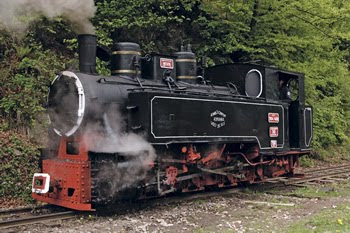The word mocăniţă is a term of endearment, derived from the Romanian word mocan, meaning shepherd or one who lives in the mountains, and suffixed as feminine and diminutive in keeping with the tradition of naming conveyances and indicating small size. Mocăniţa is a narrow gauge railway in Romania, most notably in Transylvania and nearby regions. They are situated in mountainous areas and the locomotives operating on them (which themselves can also be referred to as mocăniţăs) are steam-powered. These railways were built for cargo and passenger services - some in the era of the Austrian-Hungarian Empire, before 1920 - but fell into disrepair over the years.
Forestry railways were widespread over Europe, especially within the Carpathian Mountains. The operating principles were very simple: following close to the river, in case of need with narrow curves (therefore the use of the narrow gauge!), and constructed to enable the small locos pulling the the empty logging cars up to the mountains and to coast down the heavy loaded trains to the saw mills.
While replaced in most of the European countries after 1945, the forestry railways in Romania survived for a long time: In 1970 the state-run forestry administration still operated more than 3.000 kms of tracks, up to 1986 still new forestry steam locos were built in Romania, and in 1989 still more than 15 forestry railway existed with together approx. 1.000 km of tracks. Some are now being rehabilitated for the purposes of tourism. Mocăniţa is one of the last remaining steam rails still in active use in Europe.
The most well-known mocăniţe:
Vasar Valley, Maramureş - 43 km long, from Vişeu de Sus to Comanu, near the Ukrainian border, though the service may terminate before then at Faina. This trip usually takes between 3 and 4 hours each way. There are two other branches: along the Novat Valley (13 km) and towards Ştevioara (3 km).
Arieş Mountains, Alba County - built in 1912; trains are now operating on Abrud to Câmpeni section of this line, that has 4 stations and 21 stops; it is planned that in the future they will run from Abrud to Turda. When operated as a non-tourist railway the journey time for the 93 kilometres trip from Turda to Abrud took some six and a half hours.
Hârtibaciu Valley, Sibiu County - from Sibiu to Agnita. This line is now designated as a historical monument, so it is saved from being scrapped and the plans to revive it may now go ahead.
Covasna County - from Covasna to Comandău - Regular journeys last occurred here in 1999, but an association was formed in 2002 to save the train and a number of trips have since been made. The inclined plane at Siclău was absolutely unbelievable, operated in the same manner as many funiculars. As soon as it could hear a wagon approaching, the resident horse shunter would appear from its box and with a little bit of persuasion shunt the wagon.
Hunedoara County - from Crişcior to Brad. The line is currently classed as a historical heritage line and used for tourism on holidays.
Mureş County - Târgu-Mureş to Band.
Moldoviţa, Suceava County - built in 1888 the German Louis Ortiep. From the 24 km of the line, there are active 4 km.
Caraş Severin County - Berzasca to Stănic, 32 km.
Photos from here.
Subscribe to:
Post Comments (Atom)









4 comments:
I went with Mocănița and it is such an amazing ride. This is a must do experience in a lifetime!
http://www.rolandia.eu/steam-train-in-viseu-de-sus/
I went with Mocănița and it is such an amazing ride. This is a must do experience in a lifetime!
http://www.rolandia.eu/steam-train-in-viseu-de-sus/
Thanks Again. Looking forward to see more content like this in future.
sbobet
It was useful, thank you
Post a Comment